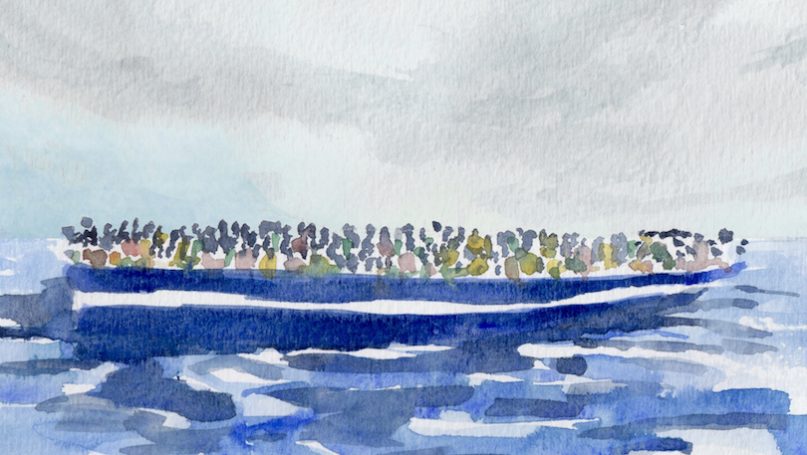
This is an excerpt from Dignity in Movement: Borders, Bodies and Rights.
Get your free download from E-International Relations.
Today, hundreds of millions of people live outside the borders of the country in which they were born. And migration trends continue to rise. By 2019, the number of global migrants reached an estimated 272 million individuals, 51 million more than in 2010 according to International Organization for Migration (IOM) data (IOM 2019a). While many individuals migrate intentionally, many others migrate involuntarily. By the end of 2020, the number of forcibly displaced people globally reached 70 million for the first time in the history of the United Nations High Commissioner for Refugees (Refugees International 2020). This number is comprised of approximately 26 million refugees, 3.5 million asylum seekers, and over 41 million internally displaced persons.
While international legal frameworks, human rights debates, and international discourse has almost exclusively been focused on the rights of migrants and forced migrants, definitions across the migration spectrum have struggled to center on a unified scope. The IOM defines a migrant as any person who is moving or has moved across an international border or within a state away from his/her habitual place of residence, regardless of the person’s legal status, whether the movement is voluntary or involuntary, what the causes for the movement are, or what the duration of the stay is (IOM 2019b). However, when counting migrants and analyzing the consequences of migration, who counts as a migrant, and a particular category of ‘migrant’ more specifically, is of pivotal importance in understanding the scope of their rights, and states’ duties. There remains no consensus on a single definition of a ‘migrant’. Within different contexts, states, and legal frameworks, migrants may be defined by foreign birth, by foreign citizenship, or by their movement to a new country to temporarily reside – whether for a short period of time, or for long-term settlement. In many instances, minors who are state-born or even nationals whose parents are foreign-born or foreign-nationals, are counted and governed under the migrant population.
While more technical linguistic definitions make a distinction between ‘immigrants’ – people who are or intend to be settled in their new country – and ‘migrants’, who are temporarily resident, both terms are often used interchangeably in public and policy discourses and even by practitioners and experts. In a number of scholarly and legal usages, people who move internally within national boundaries are also referred to as migrants. As this distinction remains overlooked and unclear, so does the more troublesome definition of a ‘forced migrant’ and all the sub-categorizations this definition entails.
The European Commission for instance, defines a ‘forced migrant’ as an individual subject to a ‘migratory movement in which an element of coercion exists’, including threats to life and livelihood, whether arising from natural or man-made causes (European Commission n.d.). In their definition, the European Commission includes the movements of refugees and internally displaced persons, as well as people displaced by natural or environmental disasters, chemical or nuclear disasters, famine, or development projects. And while the European Commission provides for a more modern and comprehensive definition than the generally ‘outdated’ one provided by the 1951 Refugee Convention, it still falls short in connecting this definition to migration, asylum, and refugee policies within the European Union and its borders.
Though it would seem imperative for a discussion that focuses on ‘migrants’ and ‘forced migrants’ – refugees, asylum seekers, internally displaced persons, etc. – to reach a consensus on what each of these terms actually denotes, since the terms have come to be used in such a large number of intersectional contexts, disciplines, and legal frameworks, one comprehensive definition remains difficult to attain. And while legal, sociological, anthropological, and even historical definitions continue to develop and zero-in on these definitions, the international community, international conventions and treaties, and international agencies have yet to develop a definition vague enough or specific enough to serve the purpose of including each and every person involved in movement.
And so, the question persists: Do the variances in definitions indicate that we have simply not attained adequate definitions? Or can definitions from across contexts, disciplines, and legal frameworks differ without contradicting one another? As the definitions across the migration discourse develop and we continue to move closer in our understanding of the intersections, overlapping circumstances, and internal and external forces that govern these definitions, this book discusses a combination of various migratory contexts and their implications.
This book brings together a diverse range of contributors to offer interdisciplinary perspectives on developments across the forced migration sphere – including reflections on international migration and refugee law, global health, border management, illegal migration, and intersectional migration experiences. The chapters address everything from the Global Compact for Migration, migration laws, fundamental human rights discourse, and principles to colonial violence, environmental migrants, and internal displacement. The book additionally delves into the interplay between such notions as the role of women in migration trends, the Kafala System, unaccompanied minors, and family dynamics. Along with tackling border practices, transnational governance, return migration, and complementary protection, the pieces featured in this volume discuss the notions of belonging, stigma, discrimination, and racism.
References
European Commission. n.d. ‘EMN Glossary Search: forced migrant’. https://ec.europa.eu/home-affairs/what-we-do/networks/european_migration_network/glossary_search/forced-migrant_en
IOM. 2019b. ‘Glossary on Migration’. Geneva: International Organization for Migration.
IOM. 2019a. ‘World Migration Report’. Annual Report, Geneva: International Organization for Migration.
Refugees International. 2020. ‘COVID-19 and the Displaced: Addressing the Threat of the Novel Coronavirus in Humanitarian Emegencies’. Issue Brief, Report, Refugees International.